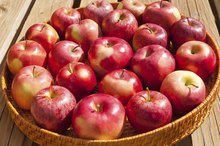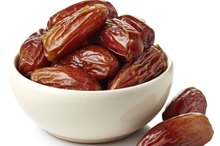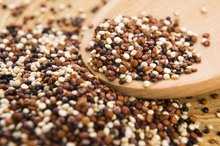Are Dates High in Insoluble Fiber?
Dates are an excellent natural source of dietary fiber, specifically insoluble fiber 1. Dates do contain soluble fiber as well, though the quantity is so low as to be insignificant. Many types of dates exist, but one popular variety is the Medjool date, and each contains 2 grams of insoluble fiber. Fiber is an important component of a healthy diet and aids in digestion, contributes to intestinal health and can aid in weight loss.
Nutrients in Dates
Dates are not only a natural source of insoluble fiber, they are also mineral-rich and provide high levels of potassium, manganese, magnesium and copper. They also supply many essential B vitamins such as niacin, vitamin B6 and pantothenic acid. Dates contain a significant amount of naturally occurring sugars which makes them an ideal substitute for refined sugars. The combination of natural sugars and insoluble fiber means that dates help regulate blood sugar levels as the sugar they provide is absorbed into the body gradually thanks to the insoluble fiber’s slowing of the digestive process.
- Dates are not only a natural source of insoluble fiber, they are also mineral-rich and provide high levels of potassium, manganese, magnesium and copper.
- The combination of natural sugars and insoluble fiber means that dates help regulate blood sugar levels as the sugar they provide is absorbed into the body gradually thanks to the insoluble fiber’s slowing of the digestive process.
Insoluble Vs. Soluble Fiber
Fruits That Are Natural Laxatives
Learn More
Dietary fiber exists in two different varieties, soluble and insoluble fiber. All plant-derived foods contain dietary fiber, though in varying quantities 1. Insoluble fiber is not broken down and absorbed by the body during digestion. As a result, insoluble fiber accelerates the digestive process and aids in preventing constipation. Soluble fiber, in contrast, acts by slowing digestion and nutrient absorption. It contributes to a feeling of satiety after eating as it requires more time to digest foods that are high in soluble fiber than it does to metabolize more highly processed foods.
- Dietary fiber exists in two different varieties, soluble and insoluble fiber.
- Soluble fiber, in contrast, acts by slowing digestion and nutrient absorption.
Sources and Benefits of Insoluble Fiber
Insoluble fiber is found in whole grains such as whole grain wheat and wheat bran, vegetables and also in the peels of many fruits such as grapes and apples. Not only is it found in foods that are loaded with vitamins and nutrients and credited with preventing constipation, insoluble fiber may also aid in the prevention of certain types of cancers, heart disease, diverticular disease and diarrhea. Despite their small size, dates are rich in insoluble fiber, for example, a serving of three dates contains more dietary fiber than a slice of white bread.
Sources and Benefits of Soluble Fiber
List of Roughage Foods
Learn More
Excellent sources of soluble fiber include fruits, legumes like beans and lentils, oat bran, barley and nuts. Fiber-rich foods are often minimally processed as the refinement process strips the food of its naturally occurring dietary fiber, such as when the bran is removed from grain to achieve a softer flour. Soluble fiber is credited with lowering cholesterol levels, relieving constipation, and having a positive impact on individuals suffering from inflammatory bowel disease, diabetes and irritable bowel syndrome.
Related Articles
References
- University of Maryland Medical Center: Fiber
- Advanced Nutrition and Human Metabolism; Sareen S. Gropper
- Tufts University: Fiber Content
- Andrews KW, and Pehrsson, PR. Individual Sugars, Soluble, and Insoluble Dietary Fiber Contents of 70 High Consumption Foods.
- Harvard University Health Services. Fiber Content of Foods in Common Portions. Adapted from Anderson JW. Plant Fiber in Foods. 2nd Edition. 1990 Li BW,
- USDA National Nutrient Database for Standard Reference, Release 20.
Writer Bio
Alberto J. Medina is a small-business owner, personal trainer and professional writer. He holds a bachelor's degree in exercise and health promotion from Virginia Tech, and is an ACE-certified advanced health and fitness specialist as well as a health coach and group fitness instructor.









